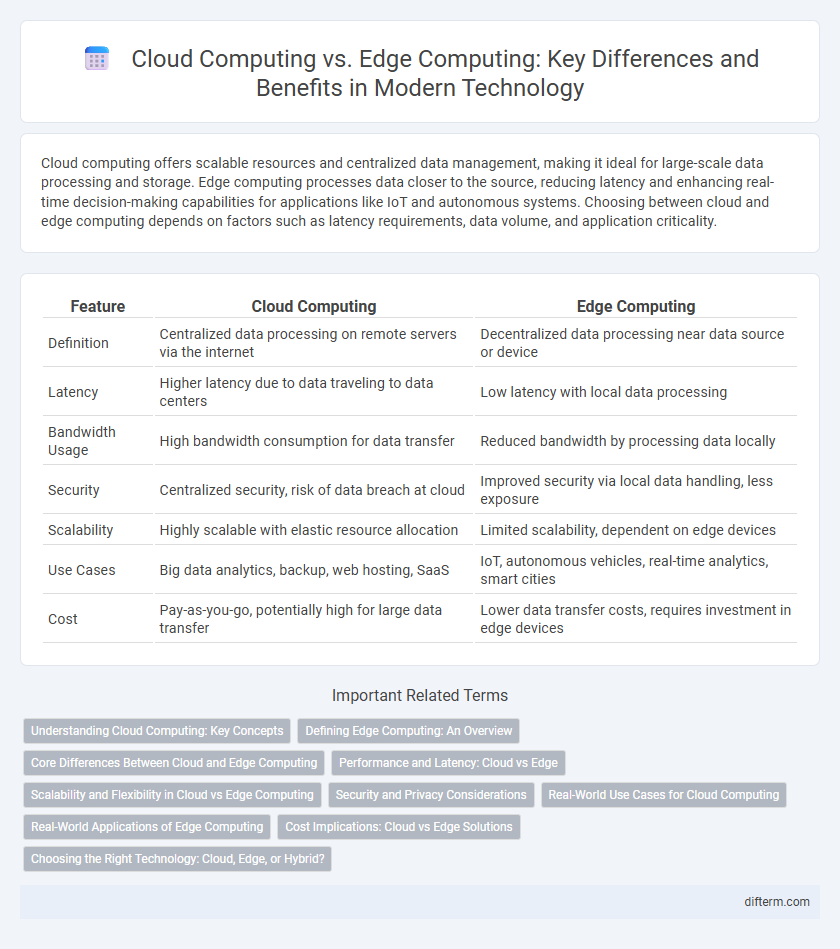Cloud computing offers scalable resources and centralized data management, making it ideal for large-scale data processing and storage. Edge computing processes data closer to the source, reducing latency and enhancing real-time decision-making capabilities for applications like IoT and autonomous systems. Choosing between cloud and edge computing depends on factors such as latency requirements, data volume, and application criticality.
Table of Comparison
| Feature | Cloud Computing | Edge Computing |
|---|---|---|
| Definition | Centralized data processing on remote servers via the internet | Decentralized data processing near data source or device |
| Latency | Higher latency due to data traveling to data centers | Low latency with local data processing |
| Bandwidth Usage | High bandwidth consumption for data transfer | Reduced bandwidth by processing data locally |
| Security | Centralized security, risk of data breach at cloud | Improved security via local data handling, less exposure |
| Scalability | Highly scalable with elastic resource allocation | Limited scalability, dependent on edge devices |
| Use Cases | Big data analytics, backup, web hosting, SaaS | IoT, autonomous vehicles, real-time analytics, smart cities |
| Cost | Pay-as-you-go, potentially high for large data transfer | Lower data transfer costs, requires investment in edge devices |
Understanding Cloud Computing: Key Concepts
Cloud computing centralizes data storage and processing on remote servers accessed via the internet, enabling scalable resources and on-demand services like SaaS, PaaS, and IaaS. Key concepts include virtualization, which allows multiple virtual machines to run on a single physical server, and multi-tenancy, supporting multiple users on shared infrastructure. Data centers hosting cloud services must ensure high availability, fault tolerance, and robust security protocols to maintain performance and protect user data.
Defining Edge Computing: An Overview
Edge computing processes data locally on devices or nearby edge servers, minimizing latency and bandwidth use compared to traditional cloud computing. It supports real-time applications like autonomous vehicles, IoT devices, and industrial automation by enabling faster decision-making and enhanced data privacy. This decentralized architecture reduces dependency on centralized data centers, improving system resilience and efficiency in handling massive data streams.
Core Differences Between Cloud and Edge Computing
Cloud computing centralizes data processing in remote data centers, offering scalable resources and extensive storage with high latency due to geographical distance. Edge computing processes data locally near the source, reducing latency and enabling real-time analytics critical for IoT devices and autonomous systems. The core difference lies in cloud's dependence on centralized infrastructure versus edge's emphasis on decentralized, proximity-based computing.
Performance and Latency: Cloud vs Edge
Cloud computing centralizes data processing in remote data centers, which can introduce latency due to physical distance and network congestion. Edge computing processes data closer to the source, significantly reducing latency and improving real-time performance for applications like autonomous vehicles and IoT devices. The proximity of edge nodes to end-users enhances responsiveness and supports latency-sensitive workloads more effectively than traditional cloud architectures.
Scalability and Flexibility in Cloud vs Edge Computing
Cloud computing offers unparalleled scalability by leveraging vast centralized data centers that can dynamically allocate resources based on demand, enabling businesses to rapidly scale applications with minimal upfront infrastructure investment. Edge computing enhances flexibility by processing data closer to the source, reducing latency and bandwidth usage while allowing real-time decision-making tailored to specific local needs. Combining cloud scalability with edge flexibility optimizes performance in distributed systems, supporting diverse workloads from large-scale analytics to immediate, localized data processing.
Security and Privacy Considerations
Cloud computing centralizes data storage and processing, increasing risks of large-scale data breaches and unauthorized access due to its broad attack surface. Edge computing enhances security by processing data locally on devices or edge servers, minimizing data exposure and latency while reducing vulnerability to centralized attacks. Privacy is improved in edge computing through localized data handling, enabling compliance with regulations like GDPR by limiting data transfer to remote cloud centers.
Real-World Use Cases for Cloud Computing
Cloud computing enables scalable data storage and processing for industries like e-commerce, finance, and healthcare, supporting applications such as online transaction processing and big data analytics. Real-world use cases include remote clinical data access for telemedicine, global content delivery via CDN networks, and enterprise resource planning systems hosted on cloud platforms. These solutions leverage centralized cloud infrastructure to provide high availability, disaster recovery, and seamless software updates across distributed user bases.
Real-World Applications of Edge Computing
Edge computing enhances real-time data processing for applications such as autonomous vehicles, smart cities, and industrial IoT by reducing latency and bandwidth usage compared to traditional cloud computing. In manufacturing, edge devices enable predictive maintenance and instant anomaly detection, improving operational efficiency. Healthcare leverages edge computing for remote patient monitoring and rapid diagnostic analysis, ensuring timely medical responses and data privacy.
Cost Implications: Cloud vs Edge Solutions
Cloud computing typically incurs ongoing costs related to data storage, bandwidth, and processing power usage, which can escalate with large-scale deployments. Edge computing reduces data transmission expenses by processing information locally, minimizing latency and bandwidth consumption, but often requires upfront investment in edge devices and maintenance. Choosing between cloud and edge solutions depends on balancing operational costs with initial capital expenditure and the specific needs for data processing speed and volume.
Choosing the Right Technology: Cloud, Edge, or Hybrid?
Choosing the right technology between cloud computing, edge computing, and hybrid solutions depends on factors like latency requirements, data processing needs, and security concerns. Cloud computing offers scalable resources and centralized data management ideal for large-scale analytics, while edge computing excels in real-time processing by bringing computation closer to data sources. Hybrid models combine both approaches, providing flexibility for organizations needing to balance performance, cost, and data sovereignty in complex environments.
Cloud computing vs Edge computing Infographic

 difterm.com
difterm.com